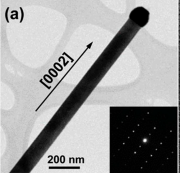Wide band gap II-VI semiconductor nanostructures have been extensively studied according to their great potentials for optoelectronic applications, while heterojunctions are fundamental elements for modern electronic and optoelectronic devices. Subsequently, a great deal of achievements in construction and optoelectronic applications of heterojunctions based on II-VI compound semiconductor one-dimensional nanostructures have been obtained in the past decade. Herein, we present a review of a series of progress in this fifield. First, construction strategies towards different types of heterojunctions are reviewed, including core-shell heterojunctions, one-dimensional axial heterojunctions, crossed nanowires heterojunctions, and one-dimensional nanostructure/thin fifilm or Si substrate heterojunctions. Secondly, optoelectronic applications of these constructed heterojunctions, such as photodetectors, solar cells, light emitting diodes, junction fifield effect transistors, etc., are discussed brieflfly. This review shows that heterojunctions based on II-VI compound semiconductor 1-D nanostructures have great potential for future optoelectronic applications.
One-dimensional (1-D) semiconductor nanostructures have been attracting a great deal of attention due to their excellent electronic and optoelectronic performance . Many high effificiency device applications were achieved based on building blocks of semiconductor nanostructures, such as photodetectors, solar cells, laser diodes, fifield-effect transistors. On the other hand, wide band gap II-VI semiconductors have been extensively studied for many years according to their great potentials for optoelectronic applications: blue-
green laser diodes based on ZnSe, high-effificiency solar cells based on CdTe thin fifilms , high performance radiation detecting devices based on CdZnTe, etc. However, there are still many diffificulties in synthesis high quality II-VI semiconductor fifilms, which hindered their electronic and optoelectronic applications. Low-dimensional, particularly one-dimensional II-VI semiconductors, have many advantages over fifilm/bulk counterparts, such as high crystalline perfection, reduced defects and controlled doping. Furthermore, they also presented excellent properties arising from unique geometries and size-confifinement effects . For instance, a CdS/CdSe/CdS biaxial nanobelt with well-defifined morphology was synthesized for high sensitivity and excellent stability photodetector, which had superior performance than thin fifilm/bulk confifigurations due to its high crystal and large surface-to-volume ratio.
Heterojunctions are fundamental elements for modern electronic and optoelectronic devices. With the rapid development of nanotechnology, heterojunctions based on semiconductor nanostructures have caught the eye of investigators all over the world due to their excellent properties. Different types of nanoscale heterojunction, such as axial, core-shell, and crossed heteorjunctions, have been constructed based on GaN, Si, ZnO. It should be pointed out that the nanoscale heterojunctions have superior performances in terms of atomically sharp interfaces, fewer interface defects, and higher emitting effificiency compared to their thin fifilm and bulk counterparts. As a result, they open up promising future for high-performance device applications, such as light emitting diodes, laser diodes, photodetectors, and solar cells. However, there are still many challenges in heterojunction fabrication process so as to be suitable for large scale and stable device applications.
Herein, we present a review on heterojunctions based on II-VI compound semiconductor one-dimensional nanostructures and their optoelectronic applications. First, construction strategies toward different types of heterojunctions are reviewed, including core-shell heterojunctions, one-dimensional axial heterojunctions, crossed nanowires heterojunctions, and one-dimensional nanostructure/thin fifilm or Si substrate heterojunctions. Secondly, optoelectronic applications of these constructed heterojunctions, such as photodetectors, solar cells, light emitting diodes, junction fifield effect transistors, etc., are discussed brieflfly. This review shows that heterojunctions based on II-VI compound semiconductor 1-D nanostructures have great potential for future optoelectronic applications.

Fig1
Yu et al. fabricated n-ZnO nanowire/p-GaN fifilm heterojunctions which were used as UV light-emitting diodes and self-powered UV detector. Mg-doped p-GaN fifilm was fifirst grown by low-temperature metal-organic chemical vapor deposition. A layer of Al2O3 insulating fifilm was then deposited via electron beam heating evaporation onto half of the GaN fifilm using a shadow mask. A single ZnO nanowire was subsequently placed across the boundary between the Al2O3 and GaN fifilms. The natural atomic bonding between the ZnO and GaN formed the p-n heterojunction. Finally, metal electrodes were deposited in order to complete the device fabrication.
上一篇: InP晶体管的热管理改进方法